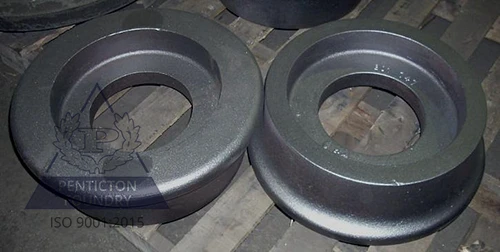ASTM A897 Grade 3 175-125-04 ISO 17804, EN-1564
on December 4, 2023

Austempered ductile iron (ADI) is an alloyed ductile iron that is heat treated by an austempering process. This austempering process includes heating the casting to a fully ferritic, homogenous condition and then cooling it to a controlled temperature above the martensitic start temperature. This isothermally transforms the matrix structure to achieve the desired properties.
ASTM A897 175-125-04 is one of 6 grades of ADI. It can be used as an alternative to steel forgings, providing cost savings with high strength and abrasion resistance.
Case Study: Read this case study on an innovative use of chrome white iron and austempered ductile iron to solve a mine’s challenge with a gyratory crusher liner.
Composition
Chemical composition is not specified in the ASTM A897 175-125-04 specification, but below is an example of chemistry ranges. The heat treater would also specify some elements like Cu, Ni, and Mo for improved heat treatment.
| C | Mn | Si | Cr | Ni | Cu | Mo | Mg | |
|---|---|---|---|---|---|---|---|---|
| Min% | 3.3 | 0 | 2.3 | 0 | 0.025 | |||
| Max% | 3.7 | 0.35 | 2.7 | 0.06 | 0.055 |
Physical and Mechanical Properties
| UTS (psi) | 175000 |
|---|---|
| TS (psi) | 125000 |
| % Elongation | 4 |
| Typical Hardness (BHN) | 341-444 |
| Density (lb/in^3) | 0.256 |
| Thermal Conductivity (BTU/hr-ft-F) | 149 |
| Coefficient Thermal Expansion | 7.8 |
| Melting Temperature (F) | 2100 |
| Compressive Strength (Ksi) | 280 |
Impact Properties
Un-notched Charpy impacts at 70F = 70 ft-lb
Notched Charpy impacts at 70 F = 7 ft-lb
Austempered Ductile Iron (ADI) Design Benefits
When deciding when to use ADI consider the following:
- ADI is lower cost, and has greater design flexibility than forgings because it is a cast product
- ADI has a greater strength-to-weight ratio than steel
- If you compare ADI to the same dimensions of steel it is lighter because it is 10% less dense1
- ADI yield strength is over 3x that of cast or forged aluminum, and only weighs 2.4 times more, while being 2.3 times stiffer2
- ADI has better wear resistance than conventional ductile iron grades
- ADI is machinable before or after the austempering heat treatment
- ADI has greater toughness than convention ductile irons, and has equivalent or better toughness than most cast or forged steels3
Pro Tip: All of the properties above are strongly dependent on the microstructure of the ADI. Therefore choosing the correct grade is important for your application.
Applications
- Grates
- Mining parts like liners and concaves
- Cart Wheels
- Gears
- CV Joints
- Sprockets
- Suspension brackets and housings
- Hitches
Reference
[1] “Section 4: Austempered Ductile Iron,” in Ductile Iron Data for Design Engineers, Montreal, Quebec: Rio Tinto Iron & Titanium Inc, 1990
[2] “Section 4: Austempered Ductile Iron,” in Ductile Iron Data for Design Engineers, Montreal, Quebec: Rio Tinto Iron & Titanium Inc, 1990
[3] “Section 4: Austempered Ductile Iron,” in Ductile Iron Data for Design Engineers, Montreal, Quebec: Rio Tinto Iron & Titanium Inc, 1990

